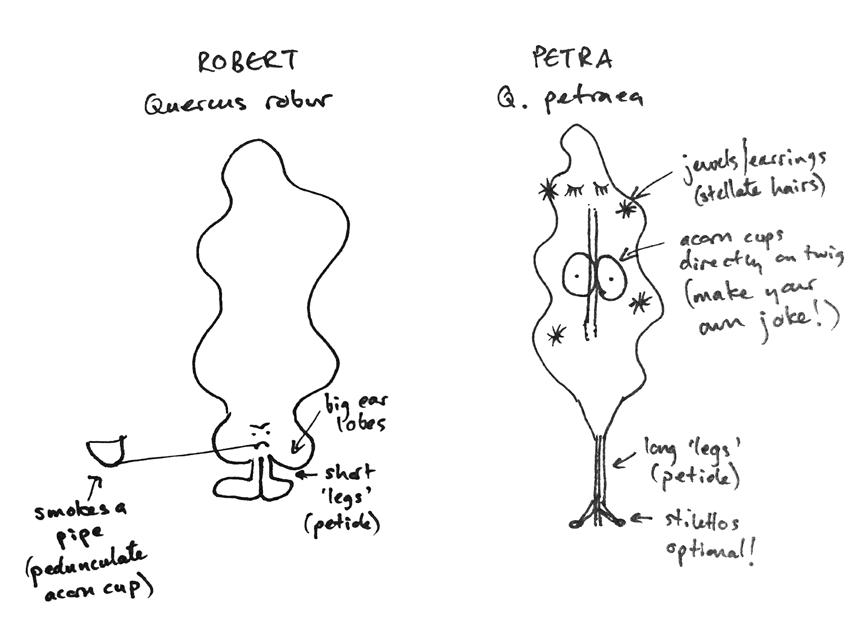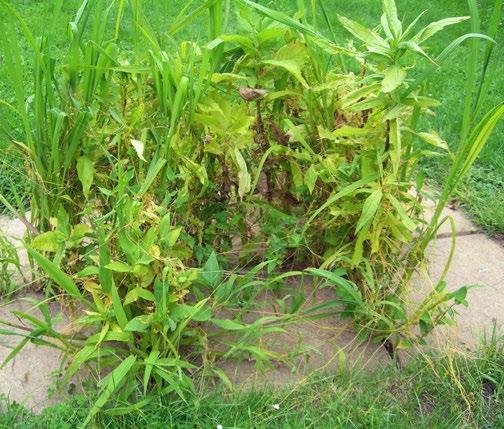
8 minute read
Short notes and notices on botanical topics
BOTANICAL NOTES
NEW FLORA OF THE BRITISH ISLES
Advertisement
This autumn the New Flora of the British Isles is 30 years old. The current fourth (and final) edition was published in January 2019; it was reprinted in August 2019, when a number of minor corrections were inserted. A second reprint is scheduled for October 2021, again incorporating corrections, but if ever further reprints are produced in future years no further corrections will be made. Electronic versions of the correction lists for both reprints can be obtained from me free of charge, and for those who cannot use these I can supply hard copy on receipt of an s.a.e. (email and postal addresses below). Please state the list(s) required.
Whenever a new Flora is produced after a long gap (39 years in this case) there are inevitably a good number of name changes that have accumulated in the interim, to which non-taxonomists are suddenly exposed in the new Flora. I can well remember the (not entirely adverse) reactions that these provoked among field botanists when CTW was first published in 1952; in that case it was 82 years since the first publication of the last major British Flora (J.D. Hooker’s The Student’s Flora of the British Islands, 1870).
The pros and cons of name changes have been much debated, and I will not add to the discussion here. However, now seems to me a good opportunity to quantify the rate of changes using the past 30 year interval, between the first edition in November 1991 and the second reprint of the fourth edition in 2021. In that period a major driver of name changing has come on the scene: molecular classification (DNA sequencing). Mainly for that reason I have attempted to divide the changes into three classes: those caused (a) by the adoption of molecular classification, (b) by other taxonomic investigations, and (c) by the more accurate application of nomenclatural rules. Quite often the changes have been due to a mixture of two or even three of these, but almost always a major cause is evident. The molecular-driven changes are usually at the generic rather than specific level, so one discovery can affect many specific names and thereby exaggerate the effect, e.g. the splitting of Chenopodium resulted in name changes to 14 species.
I counted the number of species and subspecies in the 1991 publication, and then the number of these that had been allocated a different name in the 2021 reprint, and divided the latter into the three categories. Taxa that are not included in both issues are therefore omitted, even though some would have revealed a name change if they had been in both, e.g. Celtica gigantea would have been Stipa gigantea in 1991. Also omitted are those few taxa whose names changed but then changed back to the 1991 state (e.g. Erodium lebelii – E. aethiopicum – E. lebelii and Polygonum arenastrum – P. depressum – P. arenastrum). The taxa counted cover all of those mentioned in the 1991 text, including those under ‘other spp.’, some of which have never occurred in the British Isles. Hybrids are excluded, because many do not have binomials. Simple splits or amalgamations of species or subspecies are not counted. Changes in the authorities are ignored.
Finally, two caveats are relevant. Firstly, the name changes that have been made are only a selection of those that could have been made; more or fewer could have been selected. For example, our 11 species of Scilla could be segregated into four genera. The changes that have been adopted are wholly my own selection. Secondly, the counts of total taxa and of those whose names have changed must be subject to an unknown degree of error by me, but surely of very few percent. The numbers presented below should not be taken as the number of taxa treated in the Flora. My analysis is shown in the table below. In summary, fewer than 10% of taxa have had a name change, of which more than a half is due to the results of molecular taxonomy.
Clive Stace
Appletree House, Larters Lane, Middlewood Green, Suffolk IP14 5HB
cstace@btinternet.com
Number % of total % of changes Total species and subspecies 3472 Total name changes 322 9.27%
Molecular changes 197 5.67% 61.18% Taxonomic changes 79 2.28% 24.54%
Nomenclatural changes 46 1.32% 14.28%
‘MOLLY HAS HAIRY KNEES’ AND OTHER CURIOUS WAYS TO REMEMBER PLANTS
For the beginner, whether on a university course, training day or group excursion, learning botanical identification can sometimes feel like an overwhelming challenge. So many characteristics to remember and each must be linked to the correct scientific and/or common name! In teaching botany, we strive to impart the most knowledge possible during our always-too-short time together in the field. Learning to key out an unfamiliar specimen is crucial, of course, but we also want to remember many plants without looking them up (again!) and for our trainees to do the same. We find that beginner botanists respond well to off-the-wall word play: rhymes, alliteration and jokes associating some characteristic of a plant with its name. The slightly rude ones seem to be the most memorable! It injects a bit of extra fun into the learning process – surely a good way of attracting and retaining new botanists of all ages – and provides a little step up to help learners remember a little bit more of what they were shown on that field trip, or means that one only has to key out Veronica persica six times instead of seven and more.
We plan to build a resource of these aidemémoires and make it available to learners and teachers. Do you have any silly or fun ways of remembering a specific plant, recognising a member of a plant group or telling the difference between similar species? For example, the classic: ‘grasses are round and sedges have edges’. Or for species, another oft-repeated: ‘Molly has hairy knees’ to distinguish Holcus lanatus (Yorkshire-fog) and H. mollis (Creeping Soft-grass). H. lanatus wears striped pyjamas, because of the pink stripes on the basal leaf sheath and is hairy all over, while H. mollis has a bare stem with hairy nodes, hence ‘Molly has hairy knees’.
Less famous but equally useful: Dryopteris filix-mas (Male Fern) looks superficially similar to Athyrium filix-femina (Lady Fern) but by describing the male fern circular sori as being like ‘balls’, while lady fern’s sori are curvy, identification is easier. Furthermore, lady fern edges are dissected and ‘frilly’ while male fern pinnules are nearly entire. Hence, male ferns have balls and lady ferns are frilly.
Sketches are even better, since looking at the characteristics of plants lends itself to visual memory (see illustration for a further example). As you can see, minimal or no artistic ability is required!
We have made up many of these over the years but many of you must have done likewise or come across examples. If you have any aids that help you remember plants and would like to share them, please email them (sketches can be photographed and emailed as image files) to Kathy Velander or Jay Mackinnon, or post to Jay Mackinnon (contact details below). Please include your full name and the source of the meme (if known, and not yourself) so we know who to attribute in every reproduction of the resource. We plan a poster for the Scottish Botanists’ Conference in November 2021 and, longer-term, an online resource. Contributions will need to be received before 15 October 2021 to be included on the poster.
Jay Mackinnon
47 Spinnaker Way, Dalgety Bay, Dunfermline KY11 9GH
j.mackinnon@napier.ac.uk Kathy Velander k.velander@napier.ac.uk Luke Gaskell
SALIX VIMINALIS HYBRIDS: BEWARE NAME SWITCHING
Bob Leaney’s helpful account of some Salix viminalis hybrids (BSBI News 147) leaves one small but important matter unmentioned. Bob wisely advises using the key in Stace (2019) and checking against the drawings and descriptions in the BSBI Handbook (Meikle, 1984). However, this will lead to confusion if one is not aware that one of the binomials has been switched around between the dates of these publications. The situation is this:
In Meikle (1984), Stace 1 (1990) and 2 (1997), S. cinerea × viminalis is called S. × smithiana Willd., while caprea × viminalis is S. × sericans Tausch ex A. Kerner (though Meikle incidentally causes further potential for confusion by his suggestion that S. × holosericea Willd. may be the correct name for this taxon). In Stace 3 and 4 (and in Sell and Murrell) S. × smithiana Willd. has become the name for the caprea/viminalis hybrid, while cinerea × viminalis is now called S. × holosericea Willd.
I hope this makes it clear. Perhaps the most prudent course is to avoid these binomials where possible and focus on the parental names. References Meikle, R.D. 1984. Willows and Poplars of Great
Britain and Ireland. BSBI Handbook No. 4.
Botanical Society of the British Isles, London. Stace, C.A. 2019. New Flora of the British Isles (4th edn). C & M Floristics, Middlewood Green, Suffolk.
Angus Hannah
Vice-county Recorder for the Clyde Isles (v.c. 100)
butesedge@yahoo.co.uk
REQUEST FOR SPECIMENS
Tolmiea menziesii (Pick-a-back-plant) and Tellima grandiflora (Fringecups) are two fairly frequently recorded plants these days. The latter perhaps more so as it is more conspicuous. If recording these, I would welcome fresh specimens (perhaps with a basal clump including rooting part). Any similar taxa (Heuchera, Tiarella, etc. would also be welcome, even if in cultivation, but with known name/provenance). Please email me if you have any queries.
Michael Wilcox
43 Roundwood Glen, Greengates, Bradford BD10 0HW
michaelpw22@hotmail.com

BIRD-FEEDER ALIENS
Aphoto sent by Clive Stace to show the diversity of alien plants growing from spilt Niger seed under his garden bird feeder. The main plants are Guizotia abyssinica, G. scabra and Echinochloa crus-galli; the broad leaves in the bottom centre and bottom right are an as yet unidentified grass which Gordon Hanson is looking at (see his paper on Niger bird seed aliens in British & Irish Botany Vol. 1 No. 4). The whole patch is being parasitised by Cuscuta campestris (the yellow strings visible bottom right).









